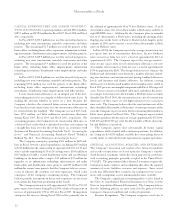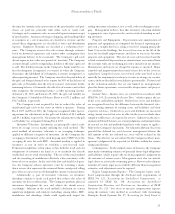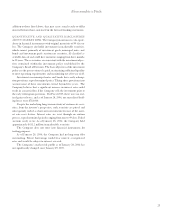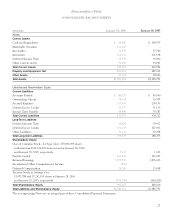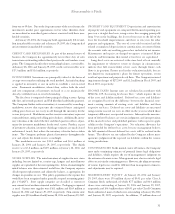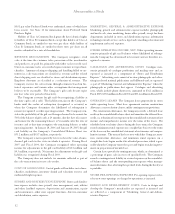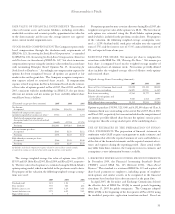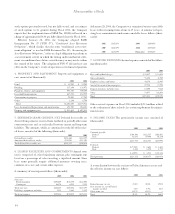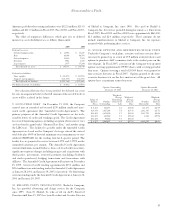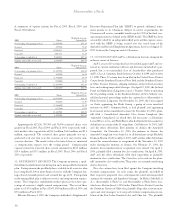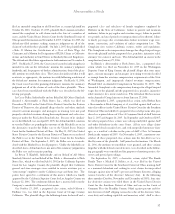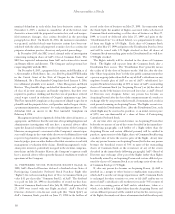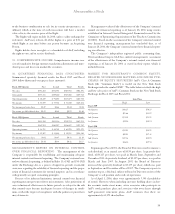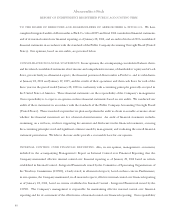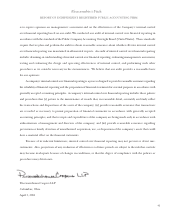Abercrombie & Fitch 2005 Annual Report Download - page 33
Download and view the complete annual report
Please find page 33 of the 2005 Abercrombie & Fitch annual report below. You can navigate through the pages in the report by either clicking on the pages listed below, or by using the keyword search tool below to find specific information within the annual report.
Abercrombie &Fitch
31
PROPERTY AND EQUIPMENT Depreciation and amortization
of property and equipment are computed for financial reporting pur-
poses on a straight-line basis, using service lives ranging principally
from 30 years for buildings, the lesser of ten years or the life of the
lease for leasehold improvements and three to ten years for other
property and equipment. The cost of assets sold or retired and the
related accumulated depreciation or amortization are removed from
the accounts with any resulting gain or loss included in net income.
Maintenance and repairs are charged to expense as incurred. Major
renewals and betterments that extend service lives are capitalized.
Long-lived assets are reviewed at the store level at least annually
for impairment or whenever events or changes in circumstances
indicate that full recoverability of net assets through future cash
flows is in question. Factors used in the evaluation include, but are
not limited to, management’s plans for future operations, recent
results of operations and projected cash flows. The Company incurred
impairment charges of $272,000 and $1.2 million in Fiscal 2005 and
Fiscal 2004, respectively.
INCOME TAXES Income taxes are calculated in accordance with
SFAS No. 109, “Accounting for Income Taxes,” which requires the use
of the asset and liability method. Deferred tax assets and liabilities
are recognized based on the difference between the financial state-
ment carrying amounts of existing assets and liabilities and their
respective tax bases. Deferred tax assets and liabilities are measured
using current enacted tax rates in effect in the years in which those
temporary differences are expected to reverse. Inherent in the measure-
ment of deferred balances are certain judgments and interpretations
of the enacted tax law and published guidance with respect to appli-
cability to the Company’s operations. No valuation allowance has
been provided for deferred tax assets because management believes
the full amount of the net deferred tax assets will be realized in the
future. The effective tax rate utilized by the Company reflects man-
agement’s judgment of the expected tax liabilities within the various
taxing jurisdictions.
CONTINGENCIES In the normal course of business, the Company
must make continuing estimates of potential future legal obligations
and liabilities, which requires the use of management’s judgment on
the outcome of various issues. Management may also use outside legal
advice to assist in the estimating process. However, the ultimate outcome
of various legal issues could be different than management estimates,
and adjustments may be required.
SHAREHOLDERS’ EQUITY At January 28, 2006 and January
29, 2005, there were 150 million shares of $0.01 par value Class A
Common Stock authorized, of which 87.7 million and 86.0 million
shares were outstanding at January 28, 2006 and January 29, 2005,
respectively, and 106.4 million shares of $0.01 par value Class B Common
Stock authorized, none of which were outstanding at January 28, 2006
and January 29, 2005, respectively. In addition, 15 million shares of
from one to 49 days. Due to the frequent nature of the reset feature, the
investment’s market price approximates its fair value; therefore, there
are no realized or unrealized gains or losses associated with these mar-
ketable securities.
At January 28, 2006, the Company held approximately $411.2 mil-
lion in marketable securities and at January 29, 2005, the Company had
no investments in marketable securities.
CREDIT CARD RECEIVABLES As part of the normal course of
business, the Company has approximately two to three days of sales
transactions outstanding with its third-party credit card vendors at any
point. The Company classifies these outstanding balances as receivables.
At January 28, 2006 and January 29, 2005, credit card receivables were
$17.3 million and $11.6 million, respectively.
INVENTORIES Inventories are principally valued at the lower of
average cost or market utilizing the retail method. An initial markup
is applied to inventory at cost in order to establish a cost-to-retail
ratio. Permanent markdowns, when taken, reduce both the retail
and cost components of inventory on hand so as to maintain the
already established cost-to-retail relationship.
The fiscal year is comprised of two principal selling seasons: Spring
(the first and second quarters) and Fall (the third and fourth quarters).
The Company further reduces inventory at season end by recording a
markdown reserve that represents the estimated future anticipated
selling price decreases necessary to sell through the inventory for the
season just passed. Markdowns on this carryover inventory represent
estimated future anticipated selling price declines. Additionally, inven-
tory valuation at the end of the first and third quarters reflects adjust-
ments for inventory markdowns for the total season. Further, as part
of inventory valuation, inventory shrinkage estimates are made, based
on historical trends, that reduce the inventory value for lost or stolen
items. The Company performs physical inventories throughout the
year and adjusts the shrink reserve accordingly.
The markdown reserve was $10.0 million and $6.6 million at
January 28, 2006 and January 29, 2005, respectively. The shrink
reserve was $3.8 million and $2.9 million at January 28, 2006 and
January 29, 2005, respectively.
STORE SUPPLIES The initial inventory of supplies for new stores
including, but not limited to, security tags, hangers and miscellaneous
supplies are capitalized at the store opening date. In lieu of amortizing the
initial balances over their estimated useful lives, the Company expenses
all subsequent replacements and adjusts the balance, as appropriate, for
changes in quantities or cost. This policy approximates the expense that
would have been recognized under generally accepted accounting princi-
ples (“GAAP”). Store supply categories are classified as current or
non-current based on their estimated useful lives. Packaging is expensed
as used. Current store supplies were $16.1 million and $16.0 million at
January 28, 2006 and January 29, 2005, respectively. Non-current store
supplies were $20.6 million at both January 28, 2006 and January 29, 2005.



